Images of the Female Body: The Middle
Ages and the Renaissance
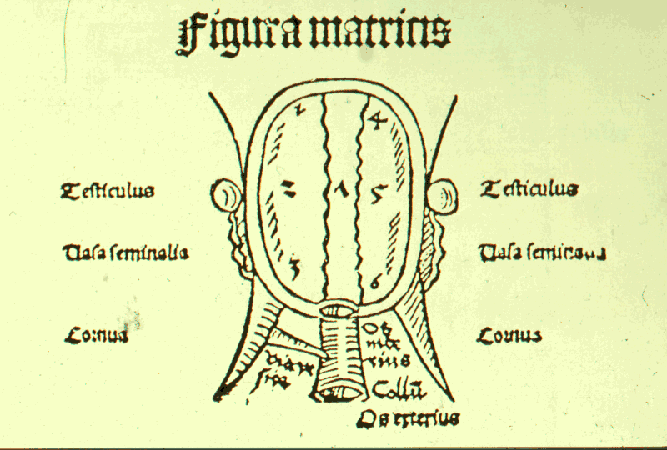 One of the most striking
and enduring beliefs about female anatomy was that the uterus had a number
of cells and especially prominent was the notion of the seven celled uterus
as shown here. Note the uterine horns derived from comparative anatomy.
Note that in Psuedo-Albertus' Women's Secrets it is mentioned that
if the male seed enters the left sections of the womb the woman will conceive
a female child and if it enters the right a male. If the seed enters the
middle cell, it will result in a hermaphrodite.
One of the most striking
and enduring beliefs about female anatomy was that the uterus had a number
of cells and especially prominent was the notion of the seven celled uterus
as shown here. Note the uterine horns derived from comparative anatomy.
Note that in Psuedo-Albertus' Women's Secrets it is mentioned that
if the male seed enters the left sections of the womb the woman will conceive
a female child and if it enters the right a male. If the seed enters the
middle cell, it will result in a hermaphrodite.
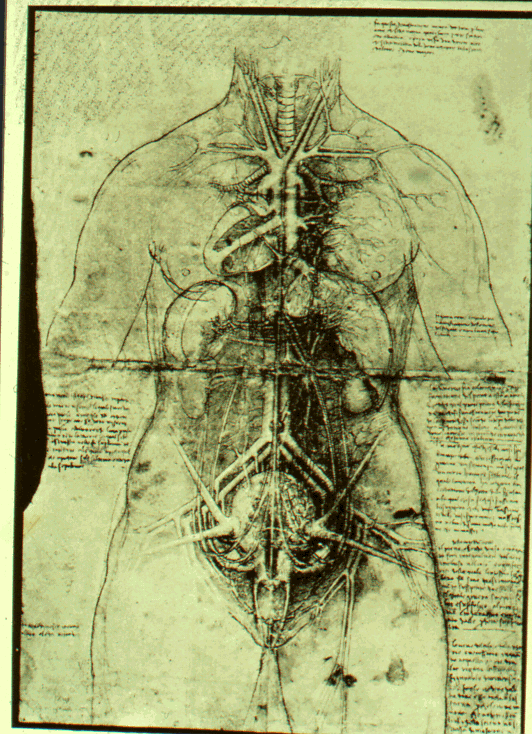 By the late 15th and
early 16th centuries more naturalistic images of the human body resulted
from a growing interest in the human form by artists such as Leonardo Da
Vinci, whose drawing of female anatomy is pictured to the right.
By the late 15th and
early 16th centuries more naturalistic images of the human body resulted
from a growing interest in the human form by artists such as Leonardo Da
Vinci, whose drawing of female anatomy is pictured to the right.
Despite advancements in illustrating the body in a more
naturalistic fashion, anatomical knowledge taken from learned medieval Islamic
and ancient texts still formed the foundation for the understanding of the
female body as seen below in Andrea Vesalius' Tabulae Sex (1538).
Note the remarkable resemblance between the male (right) and female (left)
reproductive systems. Also note the continued presence of the uterine horns.
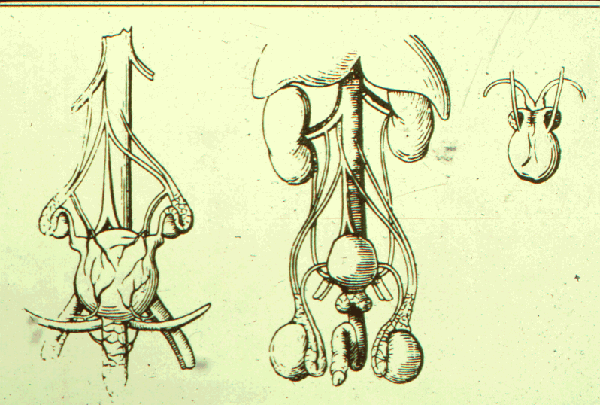
In another 16th century anatomical text (pictured below)
we see an illustration of the female reproductive organs focusing on the
vagina in particular which resembles the male penis. What does this and
the above images tell us about the ways in which the female body was understood?
Why was the one-sex model adhered to so vigorously and still valid during
this period when dissections were more common? Taken from text by Valverde,
1586.
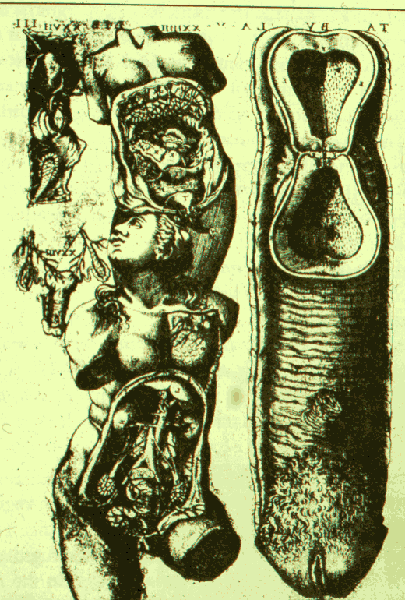
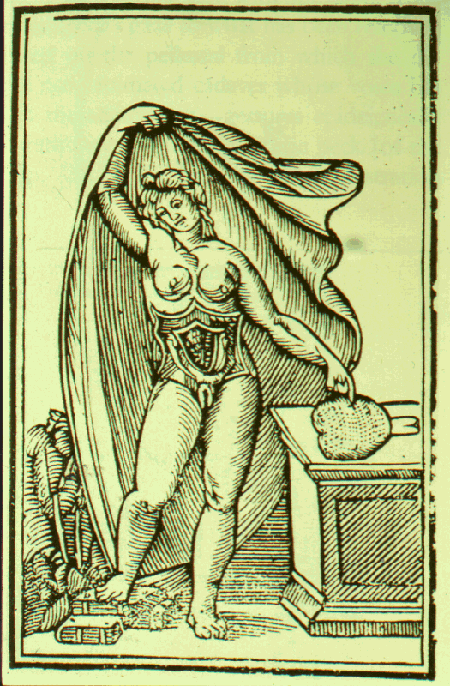 While
Vesalius and Valverde offer anatomical texts and illustrations in order
to show and teach others about women's secrets, there is a growing sense
of play regarding who the dissector really was. In this case, the woman
is revealing her own secrets, particularly her enlarged womb. The notion
of self display was often associated with women during this period. 16th
century.
While
Vesalius and Valverde offer anatomical texts and illustrations in order
to show and teach others about women's secrets, there is a growing sense
of play regarding who the dissector really was. In this case, the woman
is revealing her own secrets, particularly her enlarged womb. The notion
of self display was often associated with women during this period. 16th
century.
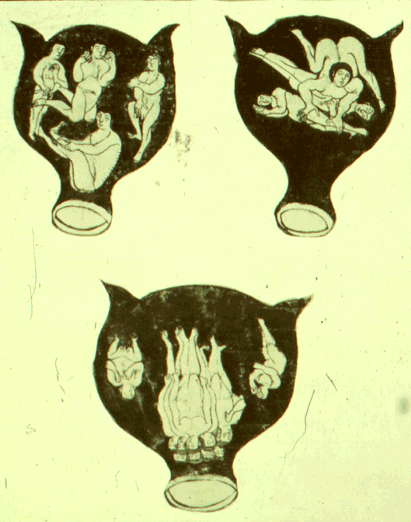 Part of the longstanding
fascination with women's secrets that continued to grow throughout the Renaissance
involved discussions about the number of fetuses that could occupy the womb
during pregnancy. This10th century image shows the possible number and positions
the fetus or fetuses in the womb. These images were still prevalent during
the 13th century and are discussed in Women's Secrets.
Part of the longstanding
fascination with women's secrets that continued to grow throughout the Renaissance
involved discussions about the number of fetuses that could occupy the womb
during pregnancy. This10th century image shows the possible number and positions
the fetus or fetuses in the womb. These images were still prevalent during
the 13th century and are discussed in Women's Secrets.
Very negative responses to the female body also resulted
from this intense fascination with women's secrets and abnormal or marvelous
acts of nature. Images such as the one below of a woman giving birth to
the Antichrist shows how culturally derived images played upon the understanding
of the female body described in texts such as Women's Secrets. What
aspects of Pseudo-Albertus' text would lend to such ideas about women?
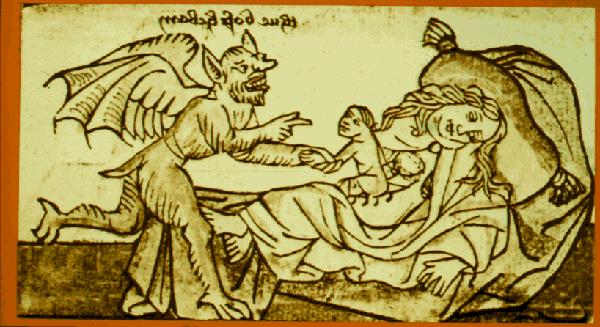
Many of the medical images of the female body were influenced
by religious beliefs. For example, women must suffer the pains of childbirth
because of the sins of Eve, depicted here reaching for the forbidden fruit.
What other religious and cultural beliefs influenced medical ideas about
the female body?
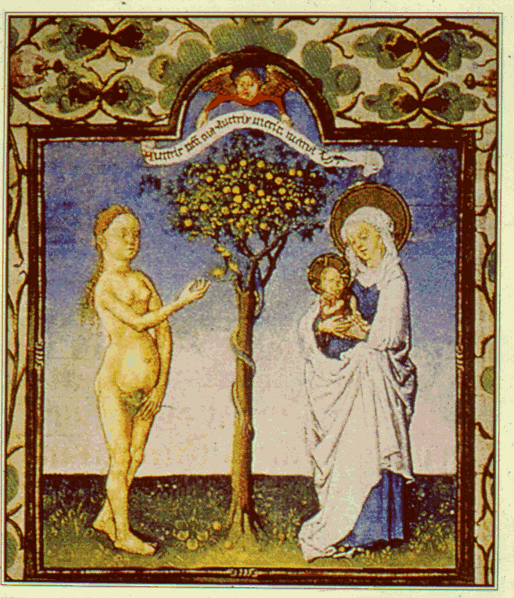
Because the female body was seen as having a cold, moist
complexion and lacked the perfection attained by that of the male, medical
writers focused a great deal on female diseases. Schematic represenations
of female maladies such as the 15th century German image below (left) were
quite common. These kinds of illustrations would have served a pedagogical
function. On the right is another schematic illustration of female diseases
along with a uroscopy chart. Uroscopy charts were created for general diseases
afflicting both sexes as well. Each disease is represented by urine of a
particular color.

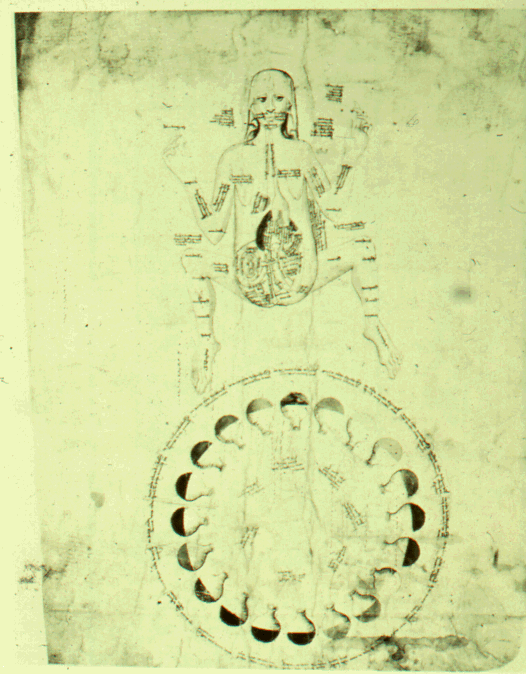
In treating their diseases, women went to both female and
male practitioners. The belief that women were capable of doing physicians'
work is represented in this mid-15th century image of Medicine as a Woman
(left). This allegorical image depicts a woman holding up a flask of urine,
often shown as the trademark of the physician in medical images during this
period. On the right is a picture of the famed Trota or Trotula who is thought
to have been a member of a group of female masters of medicine. Note the
resemblance of the two images. Both images reinforce the belief that during
the Middle Ages it was not inconceivable for women to be highly learned
in medicine.
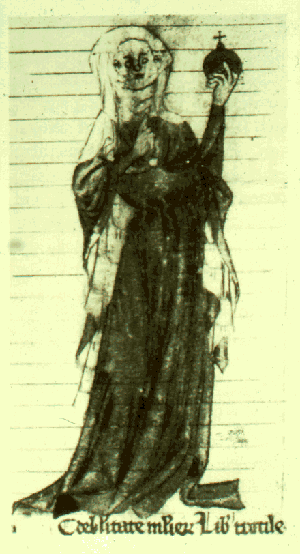
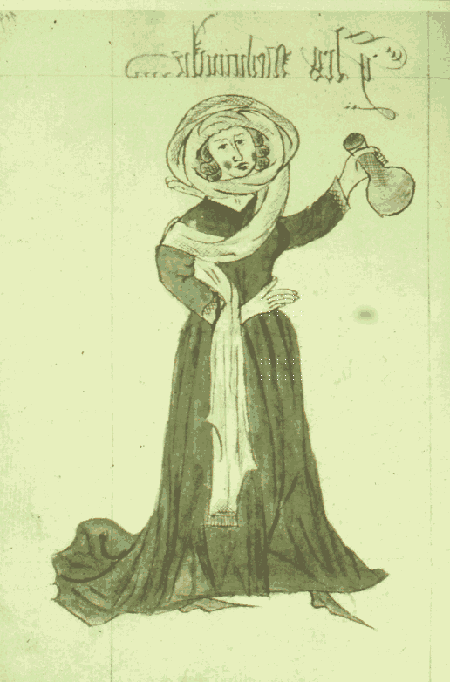
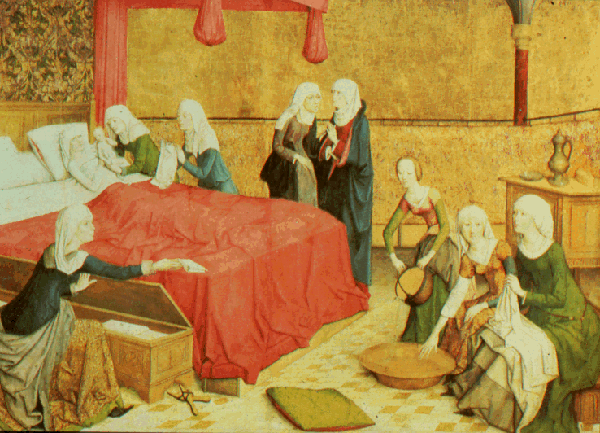
The most common area of women's health that
female practitioners were associated with was childbirth. Above is a typical
image of the birth scene which was traditionally viewed as women's domain.
Although female practitioners are thought to have been most closely tied
with childbrith, they often dealt with everyday illnesses as well. They
treated both male and female patients. Below is an image of a female practitioner
cupping a woman in order to suck the poisons out of her body. Thus, we see
that women were involved in all kinds of medical practice.
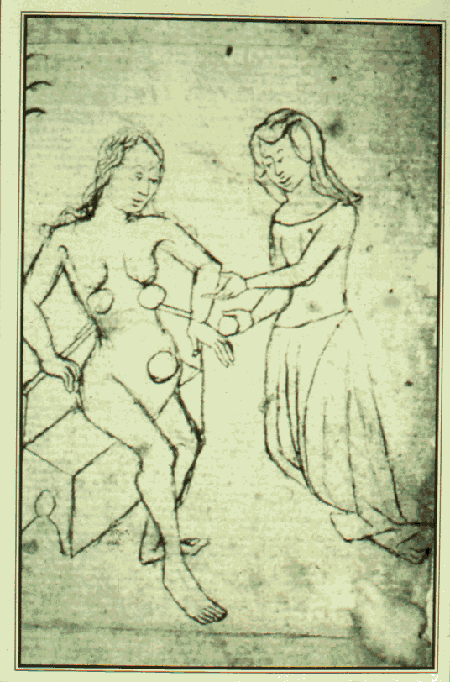
 The next two images show the
growing attempts by physicians to regulate and supervise the actions of
the female practitioner. How is the birth scene below different from the
one above? What does it say about the relationship between medical theory
and practice during the 16th century? Note the male practitioner in the
back of the scene. J.Rueff, De conceptu et gen. hominis (1580).
The next two images show the
growing attempts by physicians to regulate and supervise the actions of
the female practitioner. How is the birth scene below different from the
one above? What does it say about the relationship between medical theory
and practice during the 16th century? Note the male practitioner in the
back of the scene. J.Rueff, De conceptu et gen. hominis (1580).
The learned male physician is also present in the image
of collecting herbs for medicine (1534). Here the female practitioner is
relegated to an inferior role in assisting the learned physician holding
up the flask of urine. Increasingly women become associated with folk knowledge
as opposed to the more valuable learned medicine of physicians. Here we
see the physicians' attempts at regulating and often suppressing female
medical practice. Physicians targeted female quacks such as the woman applying
leeches to a patient's foot as particularly dangerous. Women along with
other unlicensed practitioners increasingly fell under the attack of learned
physicians.
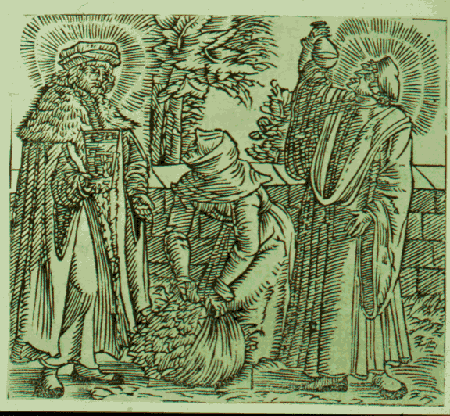

Perhaps more than any other image, the witch embodied notions
of the corruption of the female body and the danger of female practitioners.
The female witch was often associated with the foolish healer and was thought
to be well versed in folk knowledge that could be used to harm others such
as methods of poisoning. Below is a 16th century image of witches.
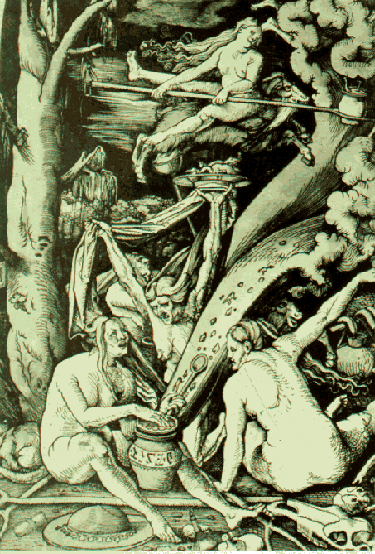
Back to Course Homepage
 One of the most striking
and enduring beliefs about female anatomy was that the uterus had a number
of cells and especially prominent was the notion of the seven celled uterus
as shown here. Note the uterine horns derived from comparative anatomy.
Note that in Psuedo-Albertus' Women's Secrets it is mentioned that
if the male seed enters the left sections of the womb the woman will conceive
a female child and if it enters the right a male. If the seed enters the
middle cell, it will result in a hermaphrodite.
One of the most striking
and enduring beliefs about female anatomy was that the uterus had a number
of cells and especially prominent was the notion of the seven celled uterus
as shown here. Note the uterine horns derived from comparative anatomy.
Note that in Psuedo-Albertus' Women's Secrets it is mentioned that
if the male seed enters the left sections of the womb the woman will conceive
a female child and if it enters the right a male. If the seed enters the
middle cell, it will result in a hermaphrodite.















